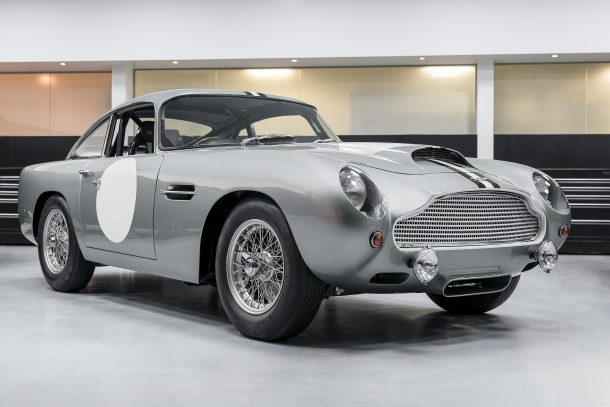Aston Martin May Return to the Inline Six With Help From Mercedes-AMG

While the United States’ obsession with massive V8 engines was picking up steam, Britain was falling in love with the inline six. In the years following World War II, Aston Martin was acquired by David Brown for a pittance and entered into the era that would define it forever. This era included the engine stylings of Tadek Marek — a man with a serious penchant for the straight six. Eventually both Aston and Marek would move on to motors with more cylinders, but the company would still hold onto the inline six until the new millennium as an entry-level option. It’s last application was on the base-model DB7.
Unless you count the DB4’s continuation, we’ve not seen any Aston Martin hosting a straight-six configuration since then. However, the company recently let slip that it’s talking about borrowing one from Daimler. Specifically, the turbocharged 3.0-liter from Mercedes-AMG.
The power plant in question is an inline-six with supplemental electric forced induction and mild-hybrid starter-alternator motor. While that may make it sound like a economy focused unit, rest assured that it is a beast. In the Mercedes-AMG CLS 53 the motor develops 429 horsepower and 384 foot-pounds of torque — augmented further by the electric trickery’s 21 extra horsepower and 184 lb-ft.
“I’ve driven it,” Aston Martin’s chief engineer Matt Becker told Australia’s Wheels in a recent interview. “We got to drive one in Stuttgart at their test facility a few months ago, and it’s a very impressive engine for sure.”
“With emissions regulations going where they’re going and getting harder and harder, we have to consider all power train options, and we are considering six-cylinders for the future. Previous Astons have had six cylinders — a long time ago — but I think with CLS 53, the engine that has is a very complicated and clever engine and it’s something that could fit with the brand in the future.”
[Images: Aston Martin; Daimler]

A staunch consumer advocate tracking industry trends and regulation. Before joining TTAC, Matt spent a decade working for marketing and research firms based in NYC. Clients included several of the world’s largest automakers, global tire brands, and aftermarket part suppliers. Dissatisfied with the corporate world and resentful of having to wear suits everyday, he pivoted to writing about cars. Since then, that man has become an ardent supporter of the right-to-repair movement, been interviewed on the auto industry by national radio broadcasts, driven more rental cars than anyone ever should, participated in amateur rallying events, and received the requisite minimum training as sanctioned by the SCCA. Handy with a wrench, Matt grew up surrounded by Detroit auto workers and managed to get a pizza delivery job before he was legally eligible. He later found himself driving box trucks through Manhattan, guaranteeing future sympathy for actual truckers. He continues to conduct research pertaining to the automotive sector as an independent contractor and has since moved back to his native Michigan, closer to where the cars are born. A contrarian, Matt claims to prefer understeer — stating that front and all-wheel drive vehicles cater best to his driving style.
More by Matt Posky
Latest Car Reviews
Read moreLatest Product Reviews
Read moreRecent Comments
- MKizzy If Tesla stops maintaining and expanding the Superchargers at current levels, imagine the chaos as more EV owners with high expectations visit crowded and no longer reliable Superchargers.It feels like at this point, Musk is nearly bored enough with Tesla and EVs in general to literally take his ball and going home.
- Incog99 I bought a brand new 4 on the floor 240SX coupe in 1989 in pearl green. I drove it almost 200k miles, put in a killer sound system and never wish I sold it. I graduated to an Infiniti Q45 next and that tank was amazing.
- CanadaCraig As an aside... you are so incredibly vulnerable as you're sitting there WAITING for you EV to charge. It freaks me out.
- Wjtinfwb My local Ford dealer would be better served if the entire facility was AI. At least AI won't be openly hostile and confrontational to your basic requests when making or servicing you 50k plus investment and maybe would return a phone call or two.
- Ras815 Tesla is going to make for one of those fantastic corporate case studies someday. They had it all, and all it took was an increasingly erratic CEO empowered to make a few terrible, unchallenged ideas to wreck it.



































Comments
Join the conversation
For me there's only two engines V8 and I6. My Toyota 7MGE burned with a bad head gasket twice, but the smoothness, the smoothness, and the torque! Love my 1UZFE V8 in the Lexus, I know a lot of folks say it lacks character, but again smoothness and big, lazy torque.
The older I get, the more I appreciate inline 6 engines. They are simple, balanced, and elegant. Despite the long crankshaft and block, which should be a detriment in the performance space, inline-6 engines don't mount transversely well. This could lead to them being seen as a performance engine, since only performance sedans and coupes will have them. Aston Martin is making a wise decision. Inline-6 engines really need to make a comeback in pickup trucks. Not sure if it can happen though, since V6's are ubiquitous in the CUV and sedan landscape.